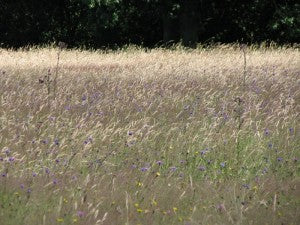What is a Wildflower Meadow?
Share
What is a Wildflower Meadow?
Dear Habitat Aid,
What is a wildflower meadow? Every time I open a magazine and read a feature about wildflower meadows they seem to look very different. Although they look lovely, I don't recognize many of the wildflowers I see in the pictures either. I want to have a wildflower meadow area in my garden and although I've read your other blog about it I'm still confused. Help!
Yours, Confused from Chiddingfold
Dear Confused from Chiddingfold,
It is confusing. It seems to me that in the UK people understand very different things by "wildflower meadow". At one end of the spectrum ecologists and conservationists call it semi-natural grassland. This is grassland untreated by herbicide and "unimproved" by fertilizers, but which has been altered by human activity like grazing livestock or cutting for hay. It is what you might think of as "traditional wildflower meadow". There are 5 different types in the UK; limestone grasslands, marshy grasslands, acid grasslands, lowland meadows and pastures, and upland hay meadows.  Their flora consists of native British grasses and wildflowers, of which they typically have between 15 and 40 species per square metre. These wildflower meadows all look quite different as their plants vary according to their locality. This variation can be very local. These three photos were taken within a month of each other, and
Their flora consists of native British grasses and wildflowers, of which they typically have between 15 and 40 species per square metre. These wildflower meadows all look quite different as their plants vary according to their locality. This variation can be very local. These three photos were taken within a month of each other, and  show different areas of the same traditional wildflower meadow around the corner from us in Somerset. It's grazed by cows, by the way. We've lost 97% of these wildflower meadows as land use has changed. Recently there has been a lot of interest in putting wildflowers back into the landscape, but in a more mannered way. Rather than trying to mimic traditional meadows, some designers are promoting meadows without grass, using native and non-native wildflowers. Nigel Dunnett calls these "pictorial meadows" and they're very voguish. There were a lot around at the Olympic site, for example. They're good for bees because they provide season long nectar flow, but they were orginally about visual impact.
show different areas of the same traditional wildflower meadow around the corner from us in Somerset. It's grazed by cows, by the way. We've lost 97% of these wildflower meadows as land use has changed. Recently there has been a lot of interest in putting wildflowers back into the landscape, but in a more mannered way. Rather than trying to mimic traditional meadows, some designers are promoting meadows without grass, using native and non-native wildflowers. Nigel Dunnett calls these "pictorial meadows" and they're very voguish. There were a lot around at the Olympic site, for example. They're good for bees because they provide season long nectar flow, but they were orginally about visual impact.
 Cornfield Annuals
Cornfield AnnualsPeople are also unclear about the difference between annuals and perennials. When some folk think of wildflower meadows they think of flowers like poppies and cornflowers - annuals. This is a slightly different thing again as they need a different regime and don't really constitute a "meadow". They also have limited biodiversity value themselves, but they're often good to combine with perennials. I hope that's helpful.
Regards, Nick Mann
Dear Nick,
Now I'm really confused. What kind of wildflower meadow area do I want in my garden? I want something which will look nice, is easy to manage, and brings bees and butterflies into my garden. Are "pictorial meadows" actually bettter for doing this? Help!
Yours, Confused
Hi Confused,
Don't despair! There's no rule about this - I want you to end up with a wildflower meadow which makes you happy. Whichever version you go for it's a myth that they're difficult to establish or manage. So long as your seeds or plants are sourced from a good supplier and you follow some basic guidelines you'll find it easy. Remember whichever type of wildflower meadow you go for will require some simple management, although much less than a lawn or border. What are your priorities? Go for a "traditional" wildflower meadow if any of these apply:
 Moths Like Meadows Too
Moths Like Meadows Too1. You're restoring or creating a meadow area in a field or paddock. 2. You want to help preserve local British wildflower populations. 3. You like the unstructured look of it. 4. Improving biodiversity generally is an important aim for you. Designer combinations of non-native and native wildflowers can provide longer nectar and pollen flow for pollinators, but a traditional wildflower meadow will give you more biodiversity generally. Native grasses, for example, provide foodplants for butterfly and moth larvae.* I should declare my interest; these tend to be the sort of people who are our clients. It's particularly important if you're going down this route to source your seeds or plants carefully, by the way. You wouldn't want to use Slovakian seed to restore a meadow in Slough. If your aims are different, by all means look at the Pictorial Meadow solution. These can give you a more designer, impressionist look, and have a longer flowering period. Don't feel that wildflowers should be restricted to wildflower meadows, by the way. You can use them in formal planting schemes or rubbing shoulders with ornamentals. Contrary to popular belief many of our native wildflowers have long flowering periods and behave beautifully in a garden setting. Good luck with your wildflower meadow, and if you've got any more questions just drop me an email.
Best, Nick
*I like the look of our grasses too, and they can be helpful in improving soil structure.


